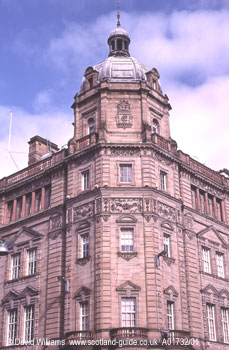The westward moves of both the city`s commercial interests and middle class housing went hand in hand, and at various times many of the houses of the Merchant City, Buchanan Street, Blythswood Hill and Woodlands Hill were either replaced by or converted into commercial buildings.
In addition, banks and insurance companies expressed their own self-confidence in the magnificent buildings which were erected in the mid and late nineteenth century. Among the best-known bank buildings are those of the Royal Bank of Scotland in Exchange Square (1827) and Gordon Street (1853-7) and the Ingram Street banking hall of the Savings Bank of Glasgow which J. J. Burnet built in 1894-1900.
Insurance companies played an important role in the development of the commercial life of the city and they also erected a number of large offices which were almost invariably embellished by numerous statues. These buildings are some of the most eye-catching pieces of Victorian architecture in the city centre and they include the Sun, Fire and Life Building (1889-94, William Leiper) and the Liverpool & London & Globe Insurance Building (1899-1901, J. B. & W. A. Thomson).
Outwith the city centre, the banks erected a number of fascinating buildings; these were often deliberately placed at busy junctions and were well-endowed with elaborate carvings in order to catch the attention of passers-by. Good examples of this type of building still exist at Govan Cross (British Linen Bank) and in Cowcaddens and Anderston, both of which had branches of the Savings Bank of Glasgow.
This article is based on the guidebook "The Glasgow Guide".
